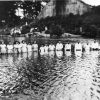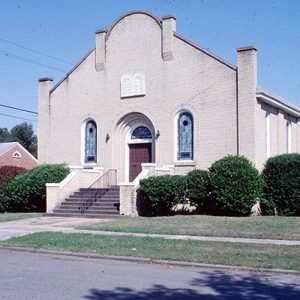calsfoundation@cals.org
Temple Meir Chayim
Temple Meir Chayim at 4th and Holly streets in McGehee (Desha County) was completed in 1947; it was designed in the Romanesque Revival style with Mission influence. The synagogue serves the Jewish community of southeastern Arkansas and is the only synagogue in McGehee.
The first documented Jewish immigrant to Arkansas was Abraham Block, who started a general store in Washington (Hempstead County) by 1825. Although the population of Arkansas had experienced growth by 1840, there were still relatively few Jewish inhabitants. In the 1850s, many Jewish businesses were concentrated in the central, southern, and eastern areas of the state, but there were few places of worship. After the Civil War, the Jewish population of Arkansas reached 4,000. There was a synagogue in Little Rock (Pulaski County) by 1845, but the first recorded congregation to receive a charter from the state legislature was Anshe Emeth in Pine Bluff (Jefferson County) in 1867.
The southeastern region of the state saw more Jewish influx in the early 1900s and after World War I, but because settlement was widely dispersed, it remained difficult to form a cohesive congregation. The worship needs of local Jewish families were met in the early 1920s when Eli Dante of Dermott (Chicot County) opened his home for High Holy Days services. In 1927, Henry Hamburger of McGehee held services in his house, as did Isadore Pinkus in Dermott. The different congregations were brought together in the McGehee Missouri Pacific Booster Hall and later the St. Paul Episcopal Church Sunday school building, also in McGehee.
In 1946, the Beth Chayim congregation was formed. The name was later changed to Meir Chayim in honor of fallen Arkansas City (Desha County) World War II sergeant Herbert M. Abowitz. A building committee raised money for a temple, which was designed by members of the committee. Plans were drawn up by Sam Wolchansky, who also oversaw construction. Materials shortages due to the war were circumvented by using lumber donated by members. The building—featuring a 150-seat sanctuary, Sunday school rooms, a recreation hall, and a kitchen—was dedicated in 1949.
Temple Meir Chayim utilized two tablets of the Ten Commandments from defunct local congregations, and the sanctuary was lit by stained-glass memorial windows. The buff brick Romanesque Revival synagogue with Mission influence has not been altered and is still utilized by Jewish congregants, but the numbers are dwindling. Temple Meir Chayim was listed in the National Register of Historic Places on April 22, 1999.
For additional information:
Dreidel, E. M. “A History of the Jews of Southeastern Arkansas: Building of Temple Meir Chayim in McGehee Fulfilled Longtime Dream.” Southern Jewish Heritage 16 (Spring 2003): 7–9.
LeMaster, Carolyn Gray. A Corner of the Tapestry: A History of the Jewish Experience in Arkansas, 1820s–1990s. Fayetteville: University of Arkansas Press, 1994.
“Temple Meir Chayim.” National Register of Historic Places nomination form. On file at Arkansas Historic Preservation Program, Little Rock, Arkansas.
Holly Hope
Arkansas Historic Preservation Program



 Temple Meir Chayim
Temple Meir Chayim 



(2013) My father owned land on 4th Street, approximately three blocks from where the Temple Meir Chayim is today. He made an exchange of property and gave the land to build the temple. It is recorded in the Desha County Courthouse and had been mentioned by E. M. (Mannie) Driedel when he wrote the history many years ago: A History of the Jews of Southeast Arkansas: Building Meir Chayim Temple McGehee, Arkansas. Sam Wolchansky oversaw the building of the temple, and my father got the material to build (which was hard to do in 194647, when these materials were hard to find). The information can be found in the book A Corner of the Tapestry. The author Carolyn LeMaster also wrote about my mother, Joan Hamburger, starting the Sunday school class when she went to see Rabbi Clark and asked him to start one for the few young children in McGehee and surrounding area. My mother was also mentioned in a book that Rabbi Clark wrote, My Diary, in which he mentions her coming to him to ask him to do this. Ms. LeMaster, the author of A Corner of the Tapestry, wrote about this tooshe had interviewed my parents in McGehee many years ago. I met her this past summer and she remembers my parents. I have so many fond memories of my temple and knowing what a big part my parents had in Meir Chayim. My father William (Bill) Hamburger was the first president, too. I am still a paying associate member.